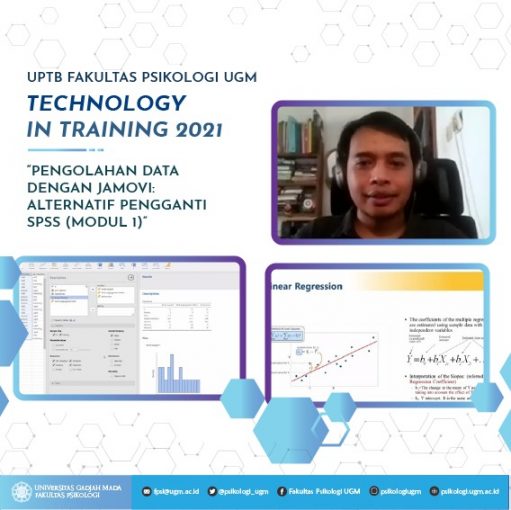
The Learning Technology Development Unit (UPTB) of the Faculty of Psychology UGM again held the second edition of Technology in Training on Friday (5/3) with the theme “Data Processing with Jamovi: An Alternative to SPSS”. This event is the second session held a few hours after the first session was held on the same day.
This event was held from 13.00 WIB to 15.00 WIB and was attended by students of the Faculty of Psychology UGM. Some of the participants took part in this event via live streaming on YouTube through the Kanal Pengetahuan Psikologi UGM channel.
The presenters for the Technology in Training this time are Wahyu Jati Anggoro S.Psi., MA. He presented about the use of Jamovi statistical processing software. This program has begun to be used in academic settings and is an alternative to the earlier popular SPSS software.
Jamovi has several advantages that have not been included in SPSS so that this software is expected to facilitate and accelerate the work of scientists to process research data. Because it is still a new product, there are still many users who don’t want to use Jamovi. This is where Anggoro explains why Jamovi is the right choice for data processing in the current era.
“Jamovi is the answer to some anxiety. Talking about data analysis, we use SPSS, right? Usually, the features are indeed very many. Also, the software is quite expensive, you have to subscribe and I don’t think all of them have more economic capacity to be able to buy SPSS software” said Anggoro.
Anggoro further explained that apart from being free, Jamovi is the right choice because it has features that are simpler than other data processing software. Jamovi does not use complicated coding, everything is already available in the menu bar and you just have to click it as needed.
In the initial session, Anggoro invited the participants to understand basic statistics again. This is very important as a basic concept for using the Jamovi software. The statistical material that he presented was focused on the processing of the final project. This is of course very beneficial for participants when they are undergoing the process of completing their final project.
Anggoro emphasized that researchers must be able to understand the data to be processed. This data identification is very important before processing the data and interpreting the results. Therefore, in his basic statistics presentation, Anggoro again explained the nominal, ordinal, interval and ratio scales.
“Why is knowledge about this data important? Because by knowing our data type, we can determine the type of data analysis that will be used” continued Anggoro.
In this training, Anggoro practiced the steps to use Jamovi, starting from simple ones, to how to use Jamovi to process and store data. He gave an example of how to use the features available at Jamovi. There are several interesting features, one of which is the Jamovi library. There, researchers can integrate Jamovi with other data processing software, for example R and Bayesian.
“There is an R Code, so we can analyze the R data, we can paste it here, and then we will run on our own” said Anggoro.
In the final session, Anggoro also gave the participants the opportunity to ask questions if there were difficulties in running the Jamovi software. In the next session of the Jamovi training, he gave the participants the opportunity to bring their respective research data to test the data processing using Jamovi.
This training event went smoothly and it really attracted the participants’ interest to further dive into the Jamovi software. The committee hopes that this training will make it easier for participants to understand how to process data properly and correctly using Jamovi.
